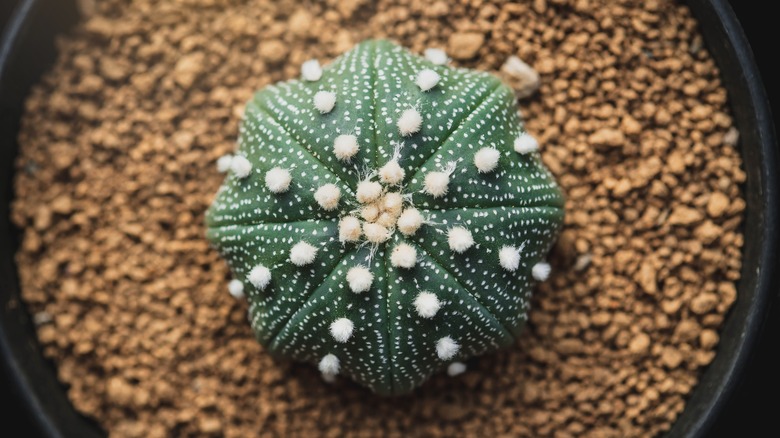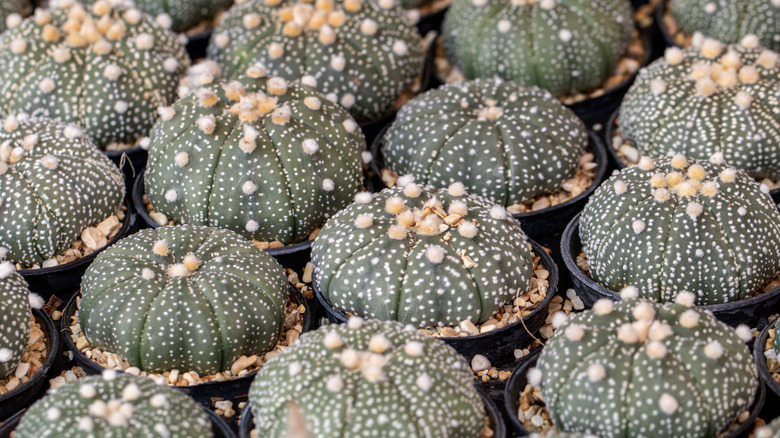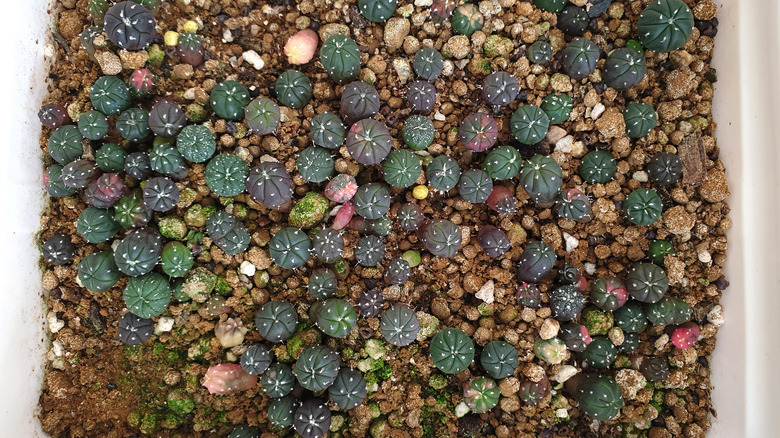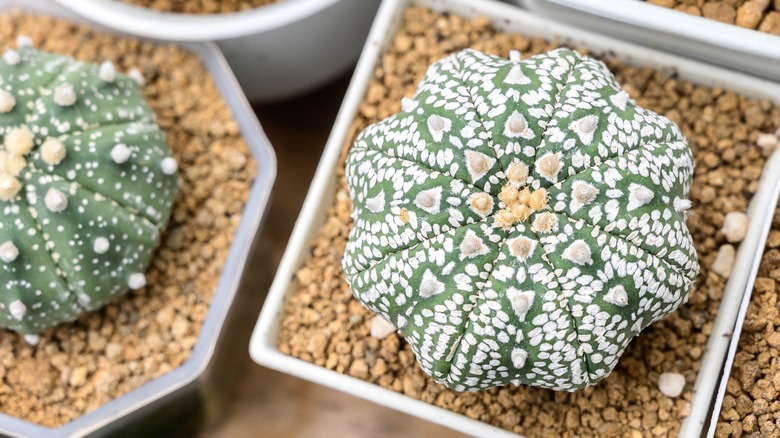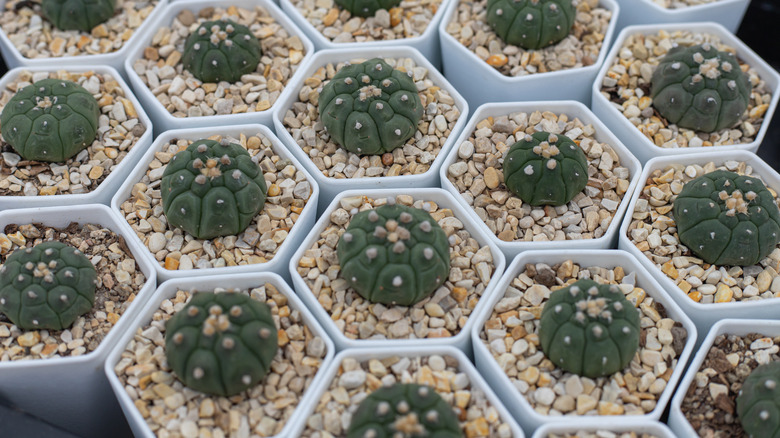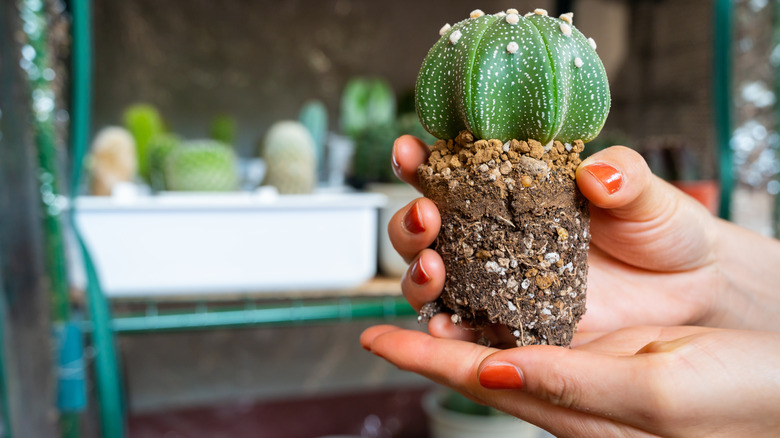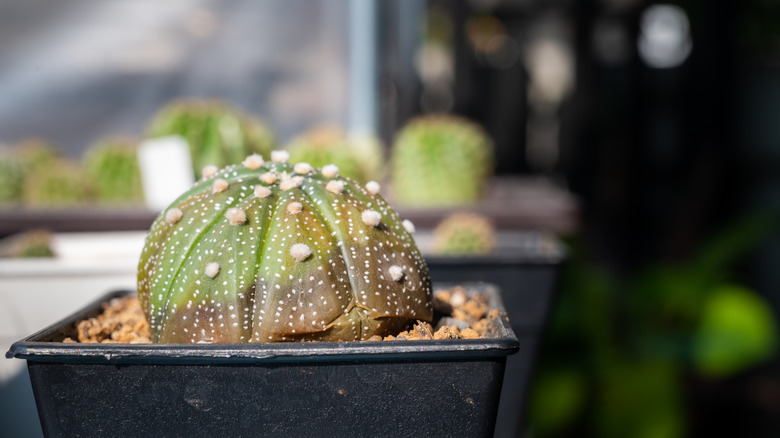How To Care For A Star Cactus
Astrophytum asterias, aka the star cactus, is a small, round cactus native to the gravelly soils of Southern Texas and Northern Mexico, as per Texas Parks and Wildlife. The cactus also goes by the sand dollar cactus, star peyote, and sea urchin cactus names. Today, it is listed as an endangered species both in the state of Texas and federally by the United States Fish and Wildlife Service.
You can identify the star cactus by its dome-shaped body made of five to eight stems which usually are a green-brown color. According to World of Succulents, in adulthood, this round plant can grow to 6 inches wide and 2.4 inches tall. Each of its stems has a row of hairy white spots called areolas surrounded by smaller white markings. In the center of the cactus are several tufts of white-ish hairs that can bloom into a beautiful yellow-orange flower during the spring or summer. So if you've been looking for a new easy-to-care-for succulent to add to your plant collection this spring, the star cactus could be just what you're looking for.
How to use a star cactus in the garden
To grow a star cactus outside, you need to live in a warm climate (20°F), namely, in the USDA hardiness zones 9, 10, or 11, as explained by Raya Garden. If you live somewhere colder, you can keep your cacti in containers outside during the summer and bring them back indoors at night and when the colder months are approaching. Astrophytum asterias do best with lots of direct sunlight. Therefore, no matter where you plant yours, be sure it will receive at least six hours of daily sun exposure, as per The Spruce.
If you plant your cactus outdoors in the garden, be sure to mimic their natural desert environment as much as possible. Good direct sunlight is only one part of this. Sublime Succulents tells us that you should also make sure that it is planted in gravelly or sandy soil where excess rainwater won't rot the cactus's roots. We suggest not growing it near leafy, humidity-loving plants. Your star cactus does not appreciate extra humidity and instead will do best in a combination cactus planter or garden.
How to grow a star cactus
Before you grow a star cactus, you will need succulent and cactus potting mix supplemented with perlite or sand and a self-draining pot. Star cacti are most often grown from seeds harvested from the plant's flower or bought from a reputable nursery. If you have little experience growing succulents and cacti, consider buying a pre-grown star cactus from your local plant store. As warned by The Spruce, Astrophytum asterias can be very difficult to grow from seeds, but you can still do it.
According to Masterclass, the first step you should take when growing this plant is to soak the seeds in water for a few hours. This will increase your chances of growing a healthy cactus. After soaking, take your seeds and plant them into your potting mix. Be sure to cover them lightly with the soil. Then, use plastic wrap to cover the container to create a greenhouse effect. Next, place your seeds in a bright area with no direct sunlight. As your seeds begin to sprout, you can start moving their container closer to the light source. After a few weeks or months, your container should have a few healthy sprouts ready to be repotted.
How to care for a star cactus
The star cactus is known to be a relatively low-maintenance plant, especially after it reaches maturity. However, as discussed, be sure to give it plenty of sunlight and watch for brown and yellow spots that may indicate that your cactus isn't getting all the direct light it needs, per Raya Garden.
Despite this cactus's nautical-esque common names, the plant actually requires very little water and humidity. Underwatering is better than overwatering it, as flooding can lead to root rot and other problems. Masterclass suggests thoroughly watering it once per month when the plant's soil has completely dried out. You may stop watering it entirely during the winter or only give it a little water as needed. This cactus species do not need fertilizer, but its appearance can benefit from the occasional feeding during the plant's growing season. Give it a balanced fertilizer with 20% nitrogen, 20% phosphorus, and 20% potassium diluted with water, The Spruce advises. Do this once per month from June to September.
Star cactus varieties
There are six species within the Astrophytum genus, according to Succulent Alley, but between those species, there are seemingly countless hybrids and variations. Astrophytum asterias alone appear to have at least 29 different cultivars, but likely much more. These are five of the most popular varieties, native to Southern Texas and Northern Mexico, as detailed by Trex Plants.
- Ooibo Kabuto has large, wooly areolas that can be white, orange, yellow, or light brown.
- Fukuryu is a ribbed variety of the star cactus with small ridges developing over its stems. Typically, this plant's rows of white tufts are much shorter than on the common star cactus.
- Superkabuto can be identified by its many white spots that form a mosaic pattern across all of the plant's stems.
- Akabana is one of the rarer varieties of star cacti with bright red-pink flowers that form in the spring and summer.
- Kikko looks much different compared to other varieties. Instead of five to eight distinct rounded stems, this variety features many blocky tubercles, resembling the shell of a turtle.
How to repot a star cactus
To repot your star cactus, you will need a self-draining pot, cactus and succulent potting mix, sand or gravel to supplement the soil, and gloves. World of Succulents recommends repotting our star cacti once per year just before their growing season; this way, your cactus will reach its full potential for height, diameter, and bloom size.
Before beginning the repotting process, ensure that your cactus's soil is entirely dried out. This will guarantee that your plant will experience the least amount of shock when being put into its new home. After putting on your gloves, remove your cactus completely from its pot. Consider running a flat tool along where the dirt meets the pot if you are struggling with this step. Once out, knock the excess dirt from your plant's roots until the rootball is mostly exposed. Next, according to The Spruce, you should partially fill your new container with potting soil and place your cactus into it. Gently pack more dirt on top of the bare roots to secure the plant in place. Don't water your star cactus just after repotting. Allow it to acclimate into its new container and finally water it after a few days to a week has passed.
Star cactus pests and problems
As with any plant, the star cactus has its own host of pests and problems that you'll need to look out for. Pest-wise, the worst threats to your cactus are scales, mealybugs, and aphids, as per Sublime Succulents. Luckily, they aren't impossible to deal with, especially if you catch them early. To get rid of these small, sap-sucking creatures, spray your cactus with a horticultural soap, which suffocates these pests. For persistent insects, spray some of the same mixture onto a cotton ball or pad and rub it directly onto the infested plant.
Besides these pests, your star cactus can be affected by a few plant diseases. Root rot and stem rot are the most common, explains Raya Garden. Both are caused by overwatering, and they can be fatal to your plant if not dealt with immediately. Root rot occurs when the roots of your cactus sit in water for too long. This can easily be prevented using well-draining potting soil and never overwatering your plant. If you suspect root rot, you can remove it from its container, cut off the affected roots, and repot it with fresh soil. Stem rot occurs in similar circumstances. You can identify stem rot in your star cactus by its watery and swollen body. The only thing you can do if you notice this is to stop watering your cactus entirely. If caught early, the plant may return to normal health.
